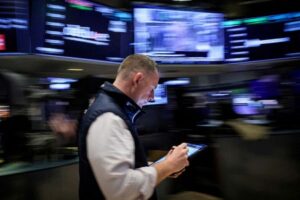LONDON (Reuters) – The latest earnings from AI darling Nvidia and key inflation numbers in the euro area and Australia should keep markets busy in the coming week.
Gold’s relentless climb to record highs and a dollar under pressure as U.S. rate cut speculation builds are also in investors’ sights.
Here’s your guide to the week ahead in financial markets from Rae Wee in Singapore, Sruthi Shankar in Bangalore, Ira Iosebashvili in New York, Yoruk Bahceli in Amsterdam, and Pratima Desai in London.
1/ NVIDIA, YOU’RE UP
Investor enthusiasm for artificial intelligence could be tested when chipmaker Nvidia reports earnings on Aug. 28.
Nvidia’s chips are seen as the gold standard in the AI-space and its shares are up around 150% this year, helping to power the S&P 500 to record highs.
But the stock’s stunning, multi-year run and the AI-mania have also drawn comparisons to the dot-com craze that imploded more than two decades ago.
Investors’ reaction to disappointing results from megacap names such as Alphabet and Tesla last month suggests markets may not be in a forgiving mood, especially when valuations for many companies in the sector are stretched.
Data highlights meanwhile include Friday’s U.S. Personal Consumption Expenditures (PCE) price index, a key inflation gauge tracked by the Federal Reserve.
2/ WHEN SEPTEMBER COMES
August euro zone inflation numbers on Friday will be key to European Central Bank policymakers deciding whether or not to cut rates in September.
The data, preceded by national releases starting on Thursday, follows a small but unexpected rise in July, highlighting a bumpy last mile in curbing inflation.
Headline inflation may ease as oil prices have fallen, but focus will remain on the core figure and the dominant services sector, where price growth remains stickier.
Any upside surprises may warrant caution, as traders have ramped up ECB rate cut bets in recent weeks. Focus has turned to growth risks, but euro zone business activity showed surprising strength in August.
Traders fully price in another 25 basis point rate cut on Sept. 12, and see a high chance of two more moves after that by year-end.
3/ HIGH STAKES
The stakes are high for the Reserve Bank of Australia (RBA), which has insisted that interest rates need to stay restrictive for an “extended period” since underlying inflation remains too high for comfort.
Wednesday’s July inflation numbers could show headline inflation diving back into the RBA’s 2-3% target band for the first time in three years.
And any signs that inflation pressures are abating could pile pressure on the central bank. It has become an outlier globally with a reluctance to lower rates while many peers look to kick off, or have already begun, easing cycles.
Investors are also hoping that Wednesday’s data could provide some relief to consumer sentiment, which has taken a hit from the weight of steep borrowing costs.
Elsewhere, Tokyo’s August inflation report on Friday potentially offers further clues on Japan’s rate outlook.
4/ EURO BULLS
The euro is at its highest this year against the dollar, benefiting from recent ructions in global markets.
Diverging U.S. and euro area rate expectations are behind its gains. Traders price around 100 bps of Fed rate cuts by year-end, up sharply from before the latest U.S. payrolls data, while only fully pricing two more 25 bps ECB cuts.
The question is whether the euro, also at its highest on a trade-weighted basis on record, can sustain its momentum.
Germany’s business activity contracted by more than expected in August, a negative sign for Europe’s economic engine, while euro zone wage growth slowed last quarter, supporting the case for an ECB September cut.
Euro bulls are a shy bunch, price action in recent years suggests. They may need more convincing of the euro’s rebound before coming out in force.
5/ ALL THAT GLITTERS
Gold has hit consecutive records since 2022, and has surged over 20% so far this year. Now $3,000 an ounce beckons.
The stars have aligned for the precious metal used primarily to preserve wealth during periods of heightened security risks and political and economic turmoil.
Russia’s war on Ukraine triggered gold’s rally in February 2022. Soaring commodity prices in the aftermath fueled inflation, which erodes the value of monetary assets.
Middle East tensions and uncertainty from the fast-approaching U.S. Presidential election have spurred further gains.
Reinforcing the buy bullion trade is the prospect of U.S. interest rate cuts, pressuring the U.S. currency and boosting gold’s appeal. It has a negative relationship with the dollar.
But gold bulls should bear in mind the old adage that “nothing goes up in a straight line” because markets typically “buy the rumour, sell the fact”.
(Compiled by Dhara Ranasinghe; Graphics by Vineet Sachdev, Sumanta Sen and Kripa Jayaram; Editing by Kim Coghill)





